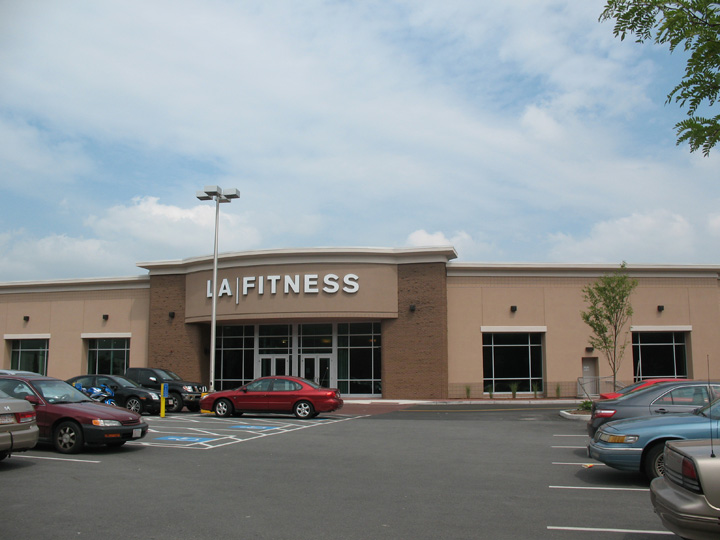
Introduction
This memorandum summarizes noise measurements and analysis performed by David Coate Consulting (DCC) on March 29, 2010 for the L.A. fitness facility in Stoneham, Massachusetts.
I understand that a resident in a nearby apartment building has complained about hearing the impact of racquet balls. This apartment building is approximately 330 feet away from the exterior wall of the racquet ball court. DCC performed a number of acoustical tests to address this concern:
1. Measured the Noise Level Reduction (NLR) of the exterior wall. This test was needed to determine whether or not this is an airborne or structure-borne problem, or some combination thereof.
2. Measured exterior racquet ball impact noise at various distances. This test was needed to extrapolate the data to the distance of the apartment building.
3. Measured racquet ball activity within the court. This test was needed in combination with the results of test #1 to determine the amount of airborne/structure-borne transmission.
4. Measured the reverberation time (RT60) within the court. This data is needed to correct for room absorption which affects the NLR test.
Existing NLR of the Exterior Wall
The NLR was measured by measuring pink noise played back at high levels within the court and just outside the exterior wall. The difference between these two data sets is the NLR, shown in Figure 1.
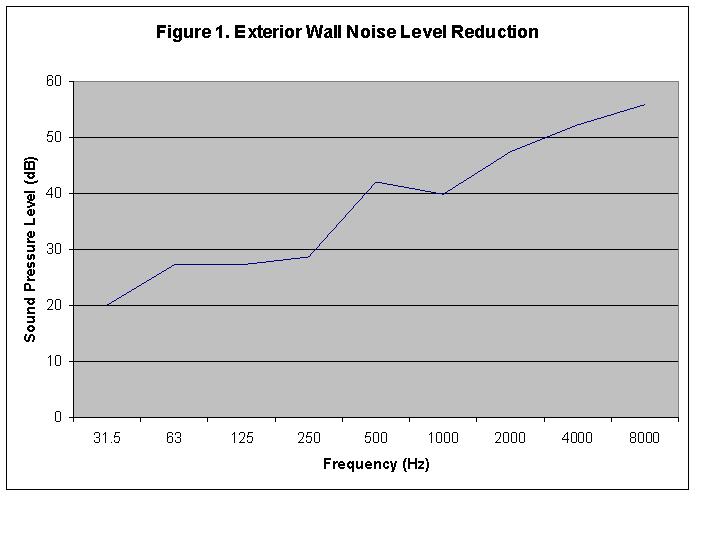
The data in Figure 1 corresponds to a Sound Transmission Class (STC) of 41. This is a moderately high STC value which suggests that the problem is structure borne. That is, a low airborne STC value would suggest that airborne sound was the issue. Based on measured game noise inside the court and the NLR data shown in Figure 1, Figure 2 shows predicted versus actual measured game noise just outside the exterior wall. The fact that the actual measured game noise level is substantially higher than that predicted if the primary transmission problem was airborne confirms that this is primarily a structure-borne noise problem.
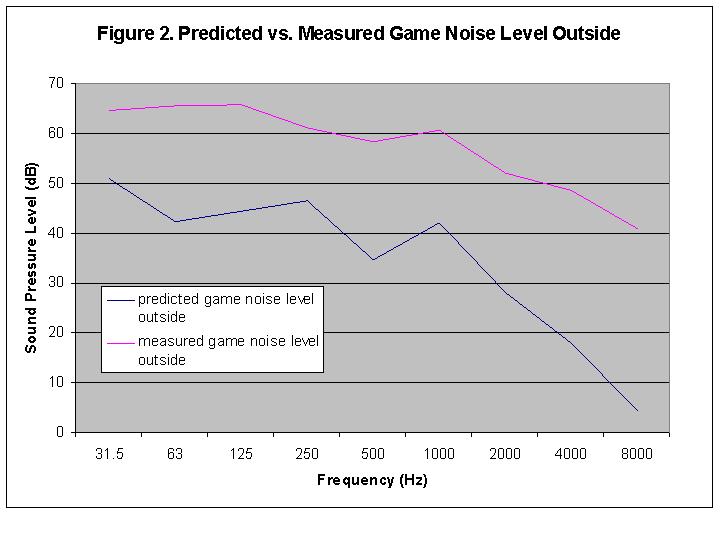
Racquetball Impact Noise at Apartment Building
High ambient sound levels because of high winds and rain precluded accurate measurements of racquetball impact noise at the adjacent apartment building. Instead, close-up measurements at 10 feet and 20 feet from the wall were extrapolated to 330 feet. Based on these measurements, peak estimated racquetball noise levels at the apartment building would be approximately 66 dBA. Please note that Lpeak values are normally not reported in acoustics because they are much higher than Leq values used to determine compliance with noise standards. In fact, the Leq of this impact noise would likely be low enough to not comprise a noise impact using common noise standards.
However, this 66 dBA peak value was substantially above the relatively high ambient noise level of 56 dBA, which indicates that racquet ball impact noise is likely audible at the apartment building, and sometimes very audible depending how low the ambient noise level is.
Treatment Options
A number of treatment options are possible in this situation, but since it is a structure-borne noise problem, the goal of the treatment would be to minimize the deflection of the wall currently caused by the impact of balls. This can be accomplished by the addition of wall mass and decoupling.
Option 1. Double Wall Construction
This option would require removal of the hit surface and construction of a new wall that does not touch the existing wall. I would recommend the addition of a layer of 5/8” GWB and then the addition of the hit wall on top of that layer. Assuming that the remaining wall cavity was half filled with loose fiberglass batting, this treatment is estimated to provide up to 12 dB improvement. Since a 10 dB improvement is considered a halving of subjective loudness, this would constitute a large and noticeable improvement.
Option 2. IsoMax Resilient Fasteners
A less robust treatment would consist of adding Kinetics IsoMax resilient fasteners, furring channel, and another hit wall all on top of the existing hit wall. This construction would be less intrusive than Option 1, but would not perform as well acoustically. An improvement to this option would be the addition of a layer of 5/8” GWB on top of the existing hit wall. This treatment is estimated to improve impact isolation 3 to 6 dB in the mid to high frequencies. This would comprise a noticeable improvement, but not nearly as much as provided by Option 1. Please note that modeling the sound isolation characteristics of building elements has an inherent margin of error which is usually dealt with by testing mockup treatments. Therefore, I suggest that Option 1 and 2 be evaluated via partial construction and then tested acoustically. Once those tests are complete, full scale treatments can be installed with confidence.
Hit Wall Acoustical Testing
On April 20, we conducted a number of tests in order to quantitatively determine the benefit of the resilient hit wall approach. The tests included measurements with the existing hit wall, and several resiliently mounted hit wall configurations.
Figure 3 shows time history impact sound data of racquet ball hits on the existing hit wall, approximately ten feet from the exterior wall. The two different sets of data were collected to determine whether or not hits were consistent. This data shows that the hits were consistent, and the average hit level was 62.5 dBA (Leq).
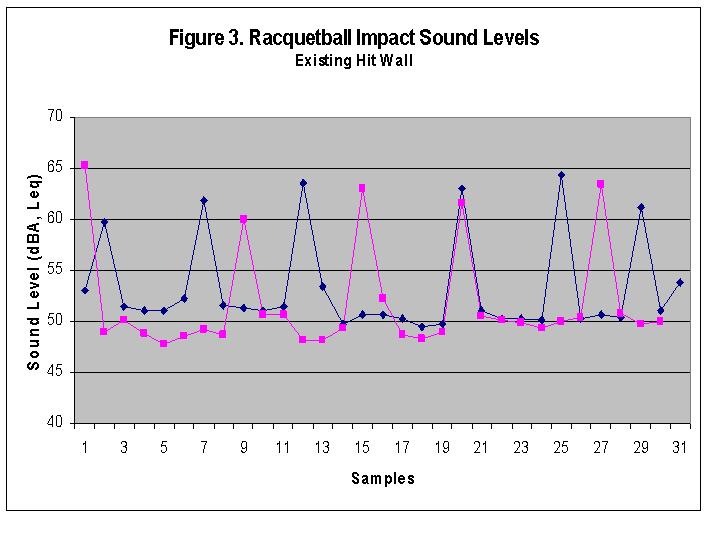
Figure 4 shows the results of testing using two hit panels resiliently mounted using 38 clips. While it is clear that sound levels were reduced, sound levels could be reduced further by eliminating some of the connection points (i.e., clips). The average hit level was 57.8 dBA, which constitutes a 4.7 dBA improvement.
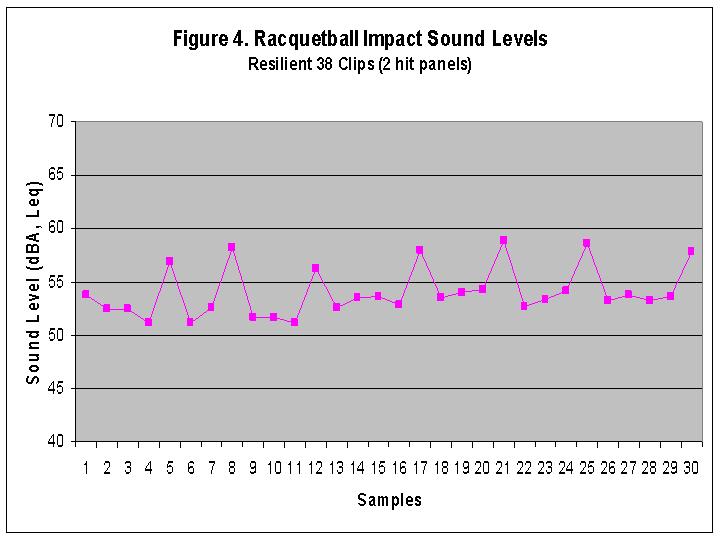
Figure 5 shows the results of reducing the number of connections to 14 clips supporting the bottom panel. Hits were only made to the bottom panel. This test showed further improvements due to reducing the number of connections. The average hit level was 55.7 dBA, which constitutes a 6.8 dBA improvement.
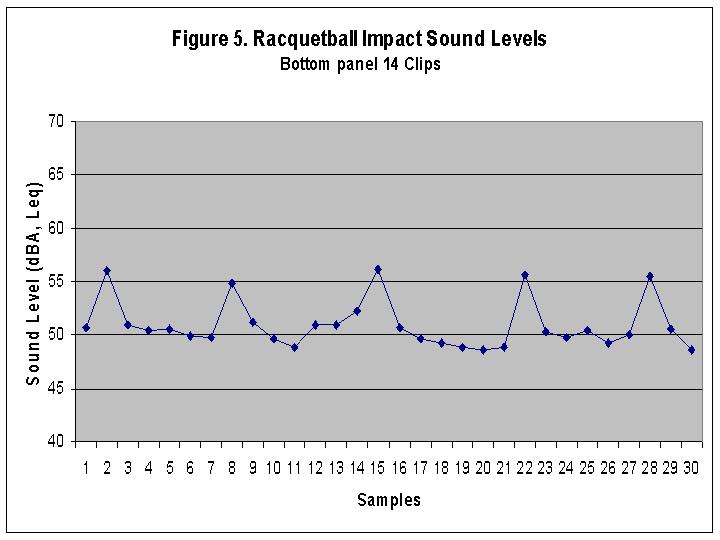
Figure 6 shows the results of reducing the number of connections to 7 clips supporting the top panel. Hits were only made to the top panel. This test showed a slight improvement to the previous test which probably indicates that the structural transmission of impacts is transferred to adjacent panels (in this case the bottom panel which had more connection points). The average hit level was 55.3 dBA, which constitutes a 7.1 dBA improvement.
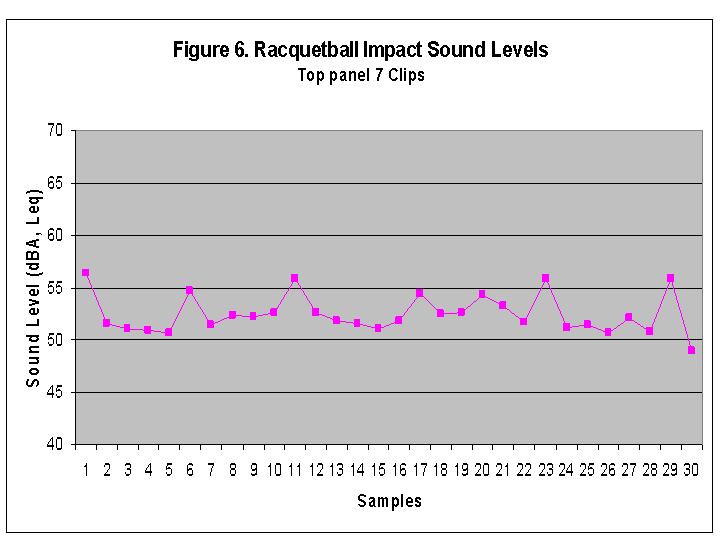
Conclusions
Substantial sound reductions consistent with my previous modeling were achieved using the IsoMax resilient clips and minimizing the number of connection points. Noise mitigation schemes are typically designed for a 10 dBA reduction, but in practice that value is rarely achieved. In this case, a 7 dBA reduction is significant and a very noticeable improvement outside of the exterior wall. While the other sound isolation methods discussed in my March 31, 2010 report would likely achieve greater reductions, they would be much more expensive than and therefore not as efficient as this particular resilient hit wall design.